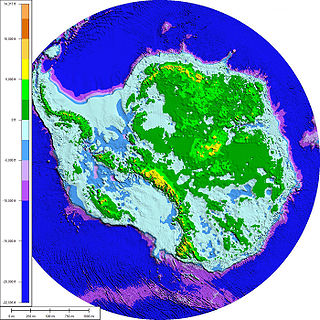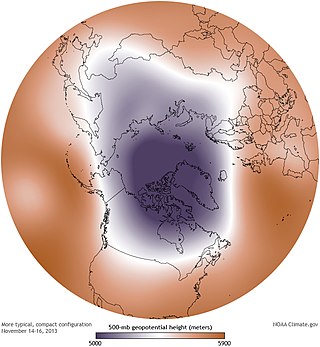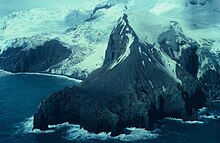
Paleoclimatology is the scientific study of climates predating the invention of meteorological instruments, when no direct measurement data were available. As instrumental records only span a tiny part of Earth's history, the reconstruction of ancient climate is important to understand natural variation and the evolution of the current climate.

The climate of Antarctica is the coldest on Earth. The continent is also extremely dry, averaging 166 mm (6.5 in) of precipitation per year. Snow rarely melts on most parts of the continent, and, after being compressed, becomes the glacier ice that makes up the ice sheet. Weather fronts rarely penetrate far into the continent, because of the katabatic winds. Most of Antarctica has an ice-cap climate with extremely cold and dry weather.

Roosevelt Island is the second largest ice rise of Antarctica and world-wide, after Berkner Island. Despite its name, it is not an island, since the bedrock below the ice at its highest part is below sea level. It is about 130 km (81 mi) long in a NW-SE direction, 65 km (40 mi) wide and about 7,500 km2 (2,896 sq mi) in area, lying under the eastern part of the Ross Ice Shelf of Antarctica. Its central ridge rises to about 550 m (1,804 ft) above sea level, but this and all other elevations of the ice rise are completely covered by ice, so that it is invisible at ground level.

The Western Antarctic Ice Sheet (WAIS) is the segment of the continental ice sheet that covers West Antarctica, the portion of Antarctica on the side of the Transantarctic Mountains that lies in the Western Hemisphere. The WAIS is classified as a marine-based ice sheet, meaning that its bed lies well below sea level and its edges flow into floating ice shelves. The WAIS is bounded by the Ross Ice Shelf, the Ronne Ice Shelf, and outlet glaciers that drain into the Amundsen Sea.

The Byrd Polar and Climate Research Center (BPCRC) is a polar, alpine, and climate research center at The Ohio State University founded in 1960.

The Antarctic oscillation, also known as the Southern Annular Mode (SAM), is a low-frequency mode of atmospheric variability of the southern hemisphere that is defined as a belt of strong westerly winds or low pressure surrounding Antarctica which moves north or south as its mode of variability.

A circumpolar vortex, or simply polar vortex, is a large region of cold, rotating air that encircles both of Earth's polar regions. Polar vortices also exist on other rotating, low-obliquity planetary bodies. The term polar vortex can be used to describe two distinct phenomena; the stratospheric polar vortex, and the tropospheric polar vortex. The stratospheric and tropospheric polar vortices both rotate in the direction of the Earth's spin, but they are distinct phenomena that have different sizes, structures, seasonal cycles, and impacts on weather.

The global temperature record shows the fluctuations of the temperature of the atmosphere and the oceans through various spans of time. There are numerous estimates of temperatures since the end of the Pleistocene glaciation, particularly during the current Holocene epoch. Some temperature information is available through geologic evidence, going back millions of years. More recently, information from ice cores covers the period from 800,000 years before the present time until now. A study of the paleoclimate covers the time period from 12,000 years ago to the present. Tree rings and measurements from ice cores can give evidence about the global temperature from 1,000-2,000 years before the present until now. The most detailed information exists since 1850, when methodical thermometer-based records began. Modifications on the Stevenson-type screen were made for uniform instrument measurements around 1880.

Pine Island Glacier (PIG) is a large ice stream, and the fastest melting glacier in Antarctica, responsible for about 25% of Antarctica's ice loss. The glacier ice streams flow west-northwest along the south side of the Hudson Mountains into Pine Island Bay, Amundsen Sea, Antarctica. It was mapped by the United States Geological Survey (USGS) from surveys and United States Navy (USN) air photos, 1960–66, and named by the Advisory Committee on Antarctic Names (US-ACAN) in association with Pine Island Bay.
The Antarctic Cold Reversal (ACR) was an important episode of cooling in the climate history of the Earth during the deglaciation at the close of the last ice age. It illustrates the complexity of the climate changes at the transition from the Pleistocene to the Holocene Epochs.

The Antarctica cooling controversy was the result of an apparent contradiction in the observed cooling behavior of Antarctica between 1966 and 2000, which became part of the public debate in the global warming controversy, particularly between advocacy groups of both sides in the public arena including politicians, as well as the popular media. In his novel State of Fear, Michael Crichton asserted that the Antarctic data contradicted global warming. The few scientists who have commented on the supposed controversy state that there is no contradiction, while the author of the paper whose work inspired Crichton's remarks has said that Crichton misused his results. There is no similar controversy within the scientific community, as the small observed changes in Antarctica are consistent with the small changes predicted by climate models, and because the overall trend since comprehensive observations began is now known to be one of warming.

Antarctica is Earth's southernmost and least-populated continent. Situated almost entirely south of the Antarctic Circle and surrounded by the Southern Ocean, it contains the geographic South Pole. Antarctica is the fifth-largest continent, being about 40% larger than Europe, and has an area of 14,200,000 km2 (5,500,000 sq mi). Most of Antarctica is covered by the Antarctic ice sheet, with an average thickness of 1.9 km (1.2 mi).
Elizabeth Mary Morris,, also known as Liz Morris, is a glaciologist and Senior Associate at the Scott Polar Research Institute, University of Cambridge. She has been a visiting professor at the University of Reading since 1995. She was head of the ice and climate division at the British Antarctic Survey, from 1986 to 1999, and president of the International Glaciological Society, from 2002 to 2005.
Ellen Mosley-Thompson is a glaciologist and climatologist. She is a Distinguished University Professor at The Ohio State University and director of their Byrd Polar and Climate Research Center. She is known as a pioneer in the use of ice cores from the Polar Regions for paleoclimatic research and is an influential figure in climate science. She is an elected fellow of the American Association for the Advancement of Science, the American Geophysical Union and an elected member of the National Academy of Sciences.

Nerilie Abram is an Australian professor at the ANU Research School of Earth Sciences, Australian National University, Canberra, Australia. Her areas of expertise are in climate change and paleoclimatology, including the climate of Antarctica, the Indian Ocean Dipole, and impacts on the climate of Australia.

Christina Riesselman is an American paleoceanographer whose research focus is on Southern Ocean response to changing climate.
Jessica E. Tierney (born 1982) is an American paleoclimatologist who has worked with geochemical proxies such as marine sediments, mud, and TEX86, to study past climate in East Africa. Her papers have been cited more than 2,500 times; her most cited work is Northern Hemisphere Controls on Tropical Southeast African Climate During the Past 60,000 Years. Tierney is currently an associate professor of geosciences and the Thomas R. Brown Distinguished Chair in Integrative Science at the University of Arizona and faculty affiliate in the University of Arizona School of Geography, Development and Environment Tierney is the first climatologist to win NSF's Alan T Waterman Award (2022) since its inception in 1975.

Amelia E. Shevenell is an American marine geologist who specializes in high-latitude paleoclimatology and paleoceanography. She is currently a Professor in the College of Marine Science at the University of South Florida. She has made notable contributions to understanding the history of the Antarctic ice sheets and published in high-impact journals and, as a result, was awarded full membership of Sigma Xi. She has a long record of participation in international ocean drilling programs and has served in leadership positions of these organizations. Shevenell served as the elected Geological Oceanography Council Member for The Oceanography Society (2019-2021).
Eric Steig is a Canadian-American scientist specializing in polar climate, glaciology, isotope geochemistry, and ice core science.














